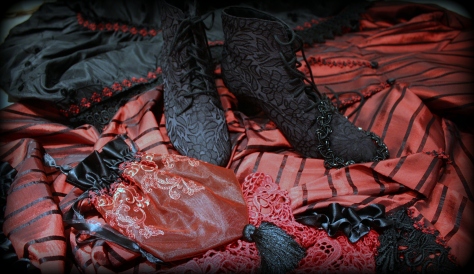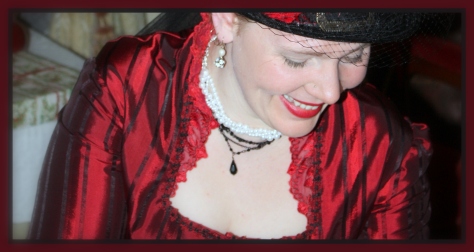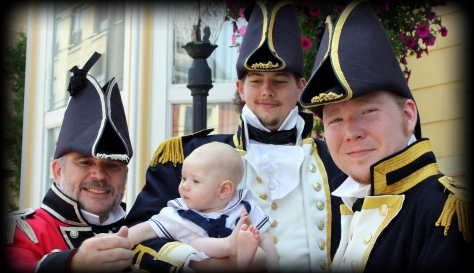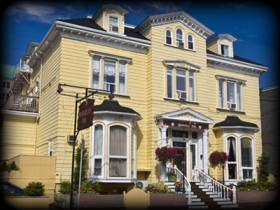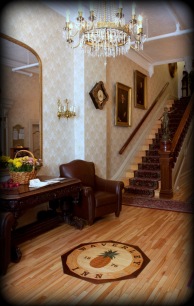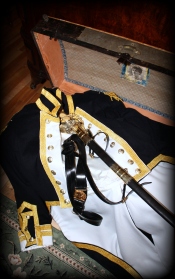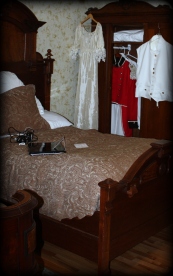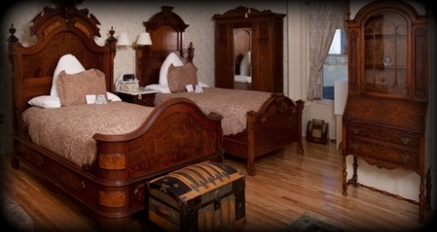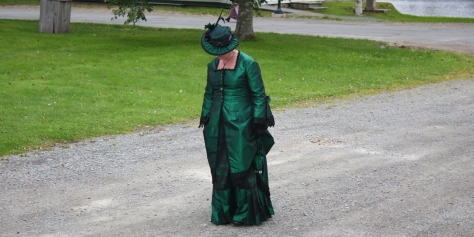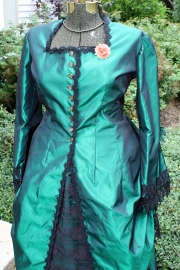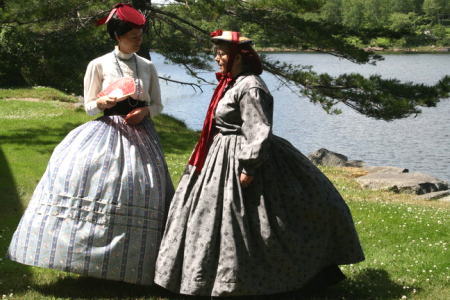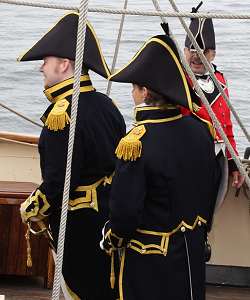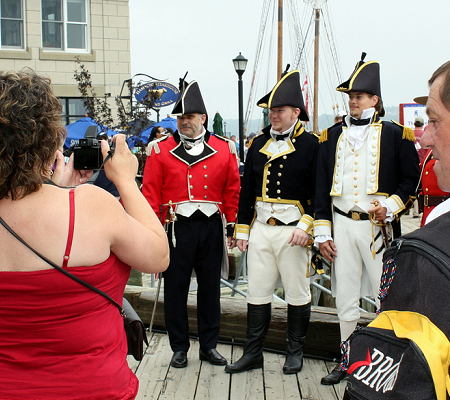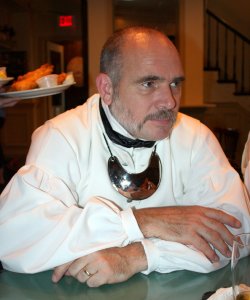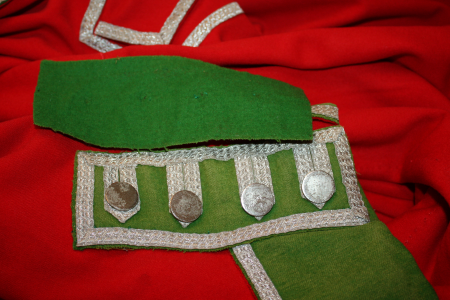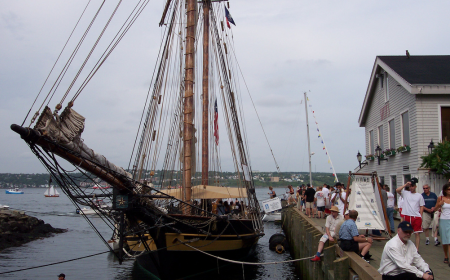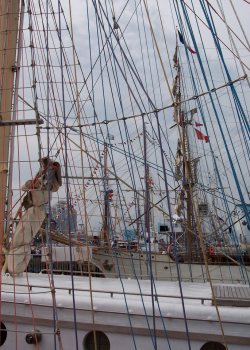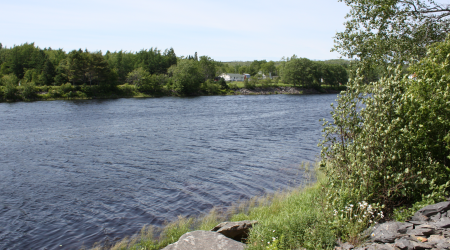
Not all Man the Capstan endeavours have been about getting dressed up in our respective uniforms and gowns. We also enjoy simply getting together and checking out a local historic site, or doing some research and posting our findings. The wonderfully evocative Sherbrooke Village in Guysborough County, Nova Scotia, has always been a place we’ve been meaning to visit. As we’re located in the heart of the Annapolis Valley, however, the distance has been the chief obstacle in the past. It’s a long haul out to Guysborough. It’s certainly possible to do in a day, but it would mean a lot of driving!
Struck by a recent itch to hit the road, the crew here at Man the Capstan decided that last weekend was a great opportunity to head east and check out Sherbrooke. We also resolved to make a slight detour to check out the Prince Henry Sinclair Monument, located along Route 16 at Halfway Cove.
 We were fortunate enough to bring along a new passenger for this venture! A close friend and colleague of mine, Katherine D. has been a great fan of Man the Capstan and has followed our efforts for over a year now. Having invited her along for the trip, she gladly accepted. Many of the photos linked within this post are hers, so just click to head on over to her Flickr Photostream!
We were fortunate enough to bring along a new passenger for this venture! A close friend and colleague of mine, Katherine D. has been a great fan of Man the Capstan and has followed our efforts for over a year now. Having invited her along for the trip, she gladly accepted. Many of the photos linked within this post are hers, so just click to head on over to her Flickr Photostream!
Arrangements were made to wake at 0530 and depart for 0700. It was an early morning! Much to our delight Katherine had elected to do some late-night baking the evening before, toiling to produce a batch of cinnamon buns for the day’s driving that was ahead of us. Let me tell you, the cinnamon buns were delicious (completely made from scratch), also making it possible to keep going without too many stops (save to grab a coffee at Tim Hortons, of course—that’s non-negotiable).
Our detour to Guysborough added a good hour or so to the drive. The route was as follows:
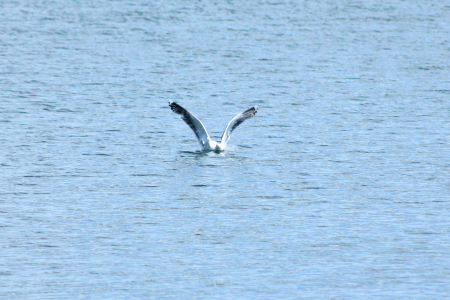
We were on the road at just after 0700, and arrived at Sherbrooke at around 1300 or so. Stops included fuelling at Truro, a stop to check out the township of Guysborough and the excursion along route 16 to Halfway Cove.
 The town of Guysborough was really quite beautiful. Tucked within Chedabucto Bay, she’s a small community but bright and cheerful. We stopped at the Days Gone By, a charming bakery, restaurant and antiques shoppe right on the main drag. Thoroughly and gratefully satiated with Katherine’s cinnamon buns, however, we didn’t really need to grab a bite to eat. We strolled down to a small marina brimming with boats, some of them yachts like the timeless MacGregor. Steve & Johanna used to own a MacGregor 26X, and whenever we spy one it conjures up lovely memories. Lots of great shots to be had there, and Katherine even snapped a rogue jellyfish just off the pier!
The town of Guysborough was really quite beautiful. Tucked within Chedabucto Bay, she’s a small community but bright and cheerful. We stopped at the Days Gone By, a charming bakery, restaurant and antiques shoppe right on the main drag. Thoroughly and gratefully satiated with Katherine’s cinnamon buns, however, we didn’t really need to grab a bite to eat. We strolled down to a small marina brimming with boats, some of them yachts like the timeless MacGregor. Steve & Johanna used to own a MacGregor 26X, and whenever we spy one it conjures up lovely memories. Lots of great shots to be had there, and Katherine even snapped a rogue jellyfish just off the pier!
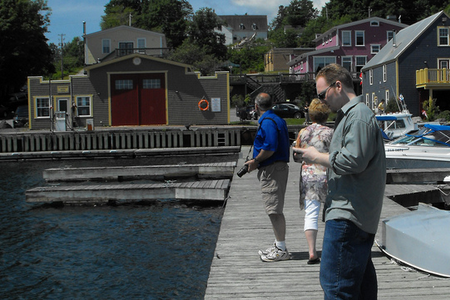
We quickly made our way to the Prince Henry Sinclair monument. It was a quick jaunt up route 16, tucked away at place named Halfway Cove. The monument, erected by the Prince Henry Sinclair Society of North America, commemorates the theory that Prince Henry Sinclair and a fleet of 12 Templar ships landed on the shores of the Chedabucto in 1398, predating the arrival of Columbus. The theory has been questioned by modern academics for decades, but the descendants of Henry Sinclair, and a few notable believers within the academic community have continued to argue the possibility. The discourse on this alleged arrival by medieval knights is both Romantic and evocative; it’s hard to say exactly what happened, and if perhaps there is truth to both sides. We here at Man the Capstan aren’t about to come to any conclusion, but it is worth mentioning that the early viking explorers at L’anse aux Meadows were also considered mythic, but now have become entrenched in modern, accepted history. Time will reveal all.

After the monument we piled into the car and headed west to Sherbrooke. It took us over an hour to make our way there, but an hour past lunch we rolled into the parking lot outside the site and made our preparations. We spent the next four to five hours plying the roads of the village, taking in the lovely sights and learning a great deal from the incredibly hospitable staff!
 We dined at the Sherbrooke Hotel, breaking our fast on sandwiches, soup and coffee. We took in a live demonstration at the blacksmith’s by a reenactor who wrought a steel hanger for us, explaining the process and even spending a moment to explain to Steve how older iron nails were fashioned. From there we made the circuit around the village, stopping in at the Post Office, Printing Press, and Drug Store. Each member of the Sherbrooke Staff took the time to explain their surroundings, offer tidbits and misconceptions on history, and explain (or demonstrate) the tools of the trade they represented. One special moment was at Cumminger’s store, where on the second floor there lies an ambrotype studio. The woman there was incredibly helpful and friendly! She immediately engaged us and explained the entire process, demonstrating the differences in colour and shade that would result from having an ambrotype photo taken; for example, a bright yellow lemon, taken next to a deep dark red apple, would both end up the same dark hue. This makes it difficult to determine the colours of garments or adornments from original photographs, and can make for some interesting science when trying to get just the right picture! The studio charges $40.00 for a shooting, fitting a maximum of three people. The Crew will most certainly return to Sherbrooke to get a picture, a la ambrotype!
We dined at the Sherbrooke Hotel, breaking our fast on sandwiches, soup and coffee. We took in a live demonstration at the blacksmith’s by a reenactor who wrought a steel hanger for us, explaining the process and even spending a moment to explain to Steve how older iron nails were fashioned. From there we made the circuit around the village, stopping in at the Post Office, Printing Press, and Drug Store. Each member of the Sherbrooke Staff took the time to explain their surroundings, offer tidbits and misconceptions on history, and explain (or demonstrate) the tools of the trade they represented. One special moment was at Cumminger’s store, where on the second floor there lies an ambrotype studio. The woman there was incredibly helpful and friendly! She immediately engaged us and explained the entire process, demonstrating the differences in colour and shade that would result from having an ambrotype photo taken; for example, a bright yellow lemon, taken next to a deep dark red apple, would both end up the same dark hue. This makes it difficult to determine the colours of garments or adornments from original photographs, and can make for some interesting science when trying to get just the right picture! The studio charges $40.00 for a shooting, fitting a maximum of three people. The Crew will most certainly return to Sherbrooke to get a picture, a la ambrotype!

The Courthouse was a wonderful building with fantastic acoustics. While within we belted out half a verse of Minstrel Boy, a song we’ve been working on and may, in the future, record at some point. It sounded gorgeous, and it was no surprise that the Courthouse is still used for musical “animations” by the Sherbrooke staff.
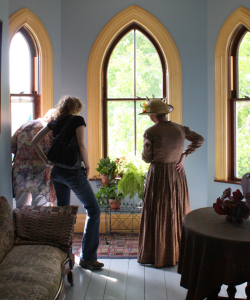
Outside we further checked out the elegant Greenwood Cottage, the Masonic Hall (No. 34 “Queen’s Lodge”), and the Doctor’s Office. The cottage was a great contrast to the rest of the town; housing the richest family during the height of the Sherbrooke gold rush, Greenwood Cottage displays the elegance found within the community. The same gentlemen who owned Cumminger’s Store also owned Greenwood Cottage (one brother stayed in Sherbrooke to handle the affairs within the village, while the other plied the seas looking for goods and trade to bring back to a booming Sherbrooke).
Our visit finally ended with the Temperance Hall, a sizeable building with a cavernous ceiling, used presently to display craftwork, predominately rug-hooking. The bottom floor of the Hall is home to a Royal Canadian Legion meeting place, perhaps one of the only dry RCL meeting places in Canada (according to our hostess).

With the tolling of the bell at 1700 we made our way to our vehicle, and began the long drive home (stopping shortly at Antigonish for a meal and a drink). Overall our trip to Sherbrooke was a huge success, and a lot of fun! Katherine added a wonderful dynamic to the Capstan Crew, constantly pointing out interesting facts and tidbits on subjects from foliage (yes, I did call that a maple) and entomology, to fantastic and old antiques and historical practices. While no surprise, Katherine also displayed an excellent taste in music; having brought her iPod along, we were exposed to some great Canadiana, from Portico to Alberta’s own Corb Lund and his “Horse Soldier, Horse Soldier”.
A great trip which made for quite the long write-up! That’s all for now, until next time.
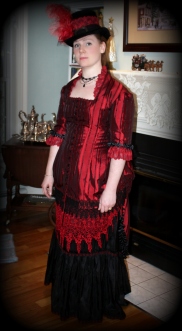 It did look wonderfully festive when it was worn to the Victorian Christmas at the O’Dell House Museum.
It did look wonderfully festive when it was worn to the Victorian Christmas at the O’Dell House Museum.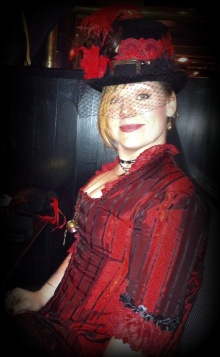 This Victorian walking gown consists of a polonaise and a walking skirt. I find it has a French feeling to it and I also like it as a riding habit. The skirt, which is made from a black embroidered taffeta, has one large ruffle and is trimmed in black and red venise laces and satin ribbon. It is slightly trained at the back.
This Victorian walking gown consists of a polonaise and a walking skirt. I find it has a French feeling to it and I also like it as a riding habit. The skirt, which is made from a black embroidered taffeta, has one large ruffle and is trimmed in black and red venise laces and satin ribbon. It is slightly trained at the back.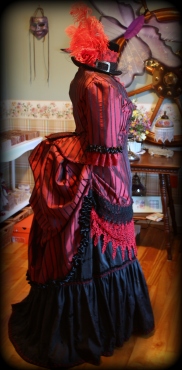 The polonaise, is made in a rich blood red and black shot striped taffeta and is fully lined and boned. It incorporates both the bodice and the over-skirt and has a nice large bustle, as well as a pleated basque at the back. It is trimmed with matching black venise lace, tulle lace at the neckline and sleeves, and ruched black satin ribbon. I had about a half yard of a very long, red, 8 inch venise lace, which matched the red of the taffeta exactly, so I added that to the front of the polonaise as well. I find it really stands out against the black of the skirt. This bodice closes at the front with black satin fabric self made buttons.
The polonaise, is made in a rich blood red and black shot striped taffeta and is fully lined and boned. It incorporates both the bodice and the over-skirt and has a nice large bustle, as well as a pleated basque at the back. It is trimmed with matching black venise lace, tulle lace at the neckline and sleeves, and ruched black satin ribbon. I had about a half yard of a very long, red, 8 inch venise lace, which matched the red of the taffeta exactly, so I added that to the front of the polonaise as well. I find it really stands out against the black of the skirt. This bodice closes at the front with black satin fabric self made buttons.